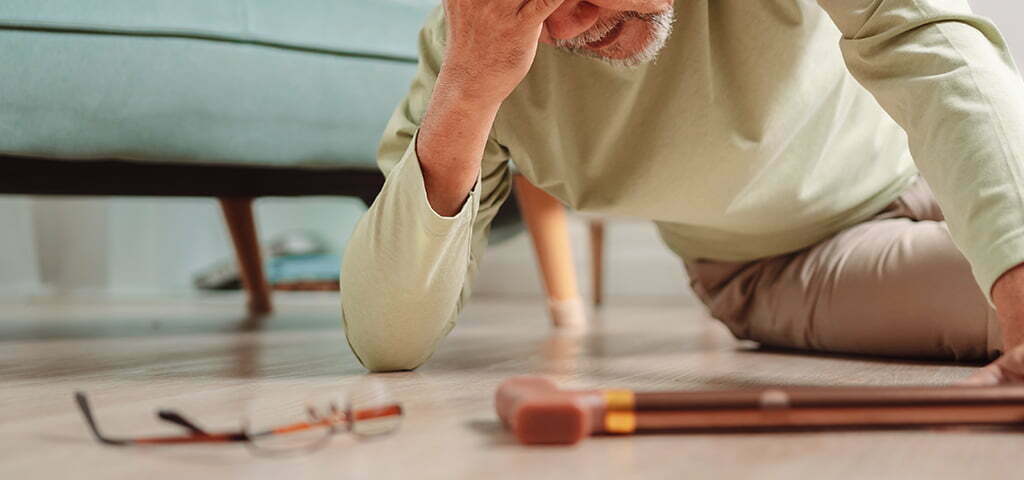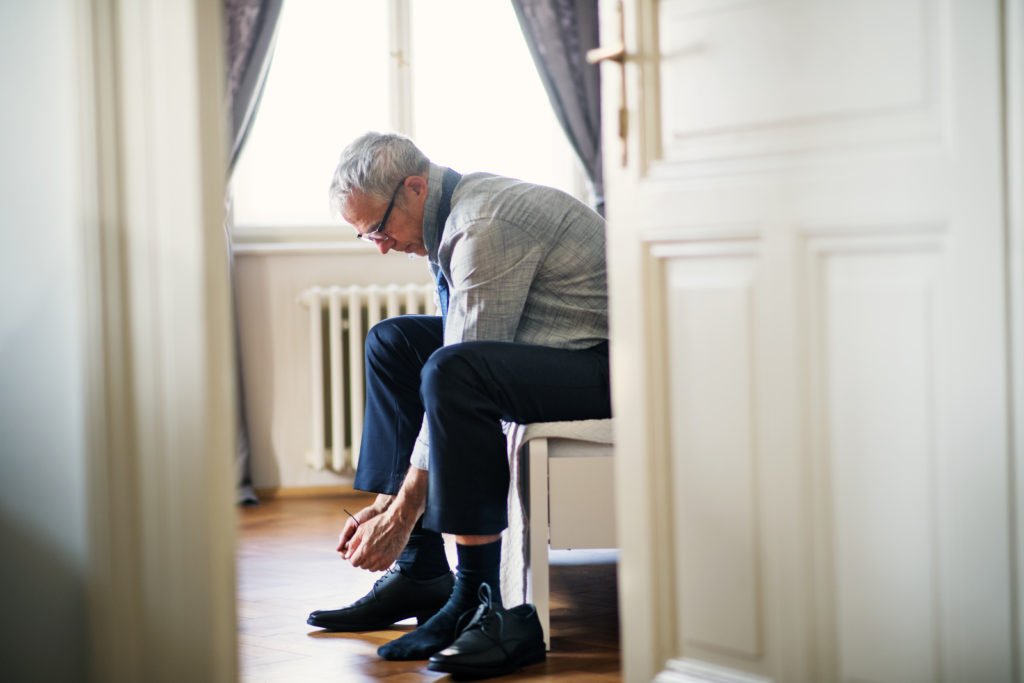Falls Prevention


Anyone can fall, but the risk of slips and trips increases as you get older. Every year one in three Canadians over 65 will fall – often with serious consequences. Hip, wrist and pelvic fractures are common in this age group and can take a toll on independence and quality of life.
The good news is there are many simple things you can do to prevent a fall:
Watch Your Step


Watch Your Step
One of the things you have complete control over is – you! There are many choices you can make that will reduce your risk of falling and protect your independence. Check out these tips for simple things you can do to stay safely on your feet.
Your Activities
- Remove your reading glasses when you are walking. Always slip them off before you take a step.
- Never climb on a chair or stool to reach something. Always ask for assistance.
- If you have a pet such as a cat or dog, consider putting a bell or reflector on its collar. It’s easy to stumble across an affectionate or sleeping pet that’s in your path.
- Take your time. If you frequently find yourself rushing to pick-up the phone, consider investing in a cordless phone that you can keep near you. Don’t rush to answer the door. The visitor will wait.
- Always sit down to put on or take off shoes and clothing. Place a chair or bench near the entranceway.
- Keep hallways and stairs free of children’s toys.
- Wear shoes or slippers with non-slip soles indoors. That means you might have to give up that pair of loose, comfy slippers with the worn soles.
- Ask for help if you need it. Most people like to lend a hand.
Reduce Your Health Risks
Your physical health can affect your risk of tripping, slipping and falling. For example, some medications can affect your alertness, judgment and coordination. Skipping meals and not drinking enough water can make you lightheaded and unsteady on your feet -especially in the hot summer months and after exercise. Poor eyesight can lead to dangerous stumbles. The good news is there are many simple things you can do to reduce your risk of an injury from falling.
Medications
Talk to your MD or pharmacist about any prescription medicines, over-the-counter products or herbal supplements you may be taking. Products can interact with each other, so it’s important to talk to your health professional about all of the things you are taking. Some medicines and supplements can cause dizziness, weakness or other side-effects that may increase your risk of slipping, tripping and falling. Advice from a health professional can reduce your risk.
Eyes & Ears
Your eyesight and hearing alert you to hazards such as traffic. Have your eyes and ears tested at least once every two years, preferably every year. Remember to take off your reading glasses when you are walking and wear your hearing aid if you need one.
Eating Well
Skipping meals can cause dizziness and weakness. Eat regular, nutritious meals to stay alert and steady. Canada’s Food Guide to Healthy Eating is a good source of information. You can find the Food Guide on the Health Canada website. It’s equally important to drink enough non-alcoholic and non-caffeinated beverages.
Feet Hurt?
Foot problems such as bunions, callouses, ingrown toenails and plantar warts contribute to unsteadiness. If your feet hurt, you are probably walking gingerly to avoid the sore spots. A chiropractor can assess your gait – the way you walk – and prescribe orthotics for your shoes if needed. Always wear good fitting, supportive shoes with non-slip soles. A podiatrist can also help correct many problems.
How’s Your Health?
Health conditions such as high blood pressure, diabetes, anemia and low blood sugar can contribute to feelings of dizziness and faintness. Talk to your health professional about what you can do to manage the symptoms of these types of conditions.
Stay Active
Being active is one of the best ways to reduce your risk of falls. Active people get more physical exercise and are more mentally alert. Social activities, sports and clubs all keep you on the move – and that’s good for your physical strength, balance and perception. Try to get at least 20 minutes of exercise at least three times a week – preferably every day. Canada’s Physical Activity Guide to Healthy Active Living for Older Adults is a good source of information. You can find it on the Health Canada website.
Practice Moderation
Know your limits and watch your alcohol consumption. Alcohol affects your sight, hearing, balance and judgment. Alone or in combination with medications, drinking too much can lead to serious falls.
Prevent Falls in the Home
As we grow older, our risk of falling increases and so does the risk of serious injury from a fall. Most trips, slips and falls happen in and around the home. Here are some simple things you can do to make sure your home doesn’t trip you up.
The Bathroom
- Use a non-slip mat inside and outside the tub or shower.
- Install grab bars by the toilet and in the tub and shower area.
- Purchase a non-slip bath and shower bench to get in and out safely.
- Install a raised toilet seat to make getting on and off easier.
The Kitchen
- Replace loose scatter mats with rugs that have rubber backing.
- Wipe up spills immediately.
- Keep everyday items on shelves within easy reach.
- Make sure no extension cords cross your path.
- Never climb on a chair or stool to reach for something. Always ask for assistance.
- Use non-slip floor wax.
- Add gliders to your chairs to make moving them easier when you sit down or get up from the table.
Stairways
- Keep stairways clear of clutter that can cause you to trip.
- Ensure there are handrails on both sides of the staircase.
- Repair loose railings.
- Install non-slip strips on the edge of each step.
- Secure loose or wrinkled carpet.
- Ensure good lighting in stairwells.
- Make sure you can see where you are going if you are carrying something up or down the stairs.
The Rest of the House
- Have a clear path from the bedroom to the bathroom. Place night lights along the way to guide you.
- Make sure tables and lamps are stable.
- Always sit down when putting on or taking off shoes and clothing.
- Don’t rush to answer the phone. Consider a cordless phone.
Outdoors
- Keep a covered bucket of sand or salt near the doorway in winter to safely handle slippery conditions.
- Make sure outdoor railings and stairs are sturdy and secure. Install railings on both sides of outdoor stairways if needed.
- Keep steps and pathways clear of clutter such as yard tools, snow shovels, newspapers and wet leaves.
- Don’t juggle parcels while trying to enter the house. Never carry more than is reasonable. Instead, make a few trips from the car with smaller packages.
Improve Your Strength and Balance
Taking a tumble can cause serious injury that affects your everyday life and independence. One of the best ways you can reduce your risk of slipping, tripping and falling is to improve your strength and balance. Almost any kind of physical activity is helpful – but some activities deliver greater benefits than others.
Strong Legs for Stability
Strengthening your leg muscles can reduce the chance of falling if you do lose your balance. Strong legs will stabilize you and can make the difference between staying on your feet and hitting the ground. While any activity that uses your legs is good, it’s important to find something you enjoy. The best exercise plan in the world won’t help if you don’t want to do it. Here are some ideas:
Brisk Walking
Walking requires no special equipment other than a pair of supportive shoes. Make an after-dinner walk part of your routine or leave the car in the driveway and take a walk to pick up light groceries. There are many simple ways to get moving more often.
Strength Training
Exercises that target specific leg muscles can be easily done at home – there’s no need to join an expensive gym. If you enjoy being with a group, community centres often have exercise programs for different age groups. Here’s a simple strengthening exercise to try:
Leg extensions:
This exercise can be done while watching TV or sitting at the kitchen table. While seated, straighten-out one leg and gently lift it off the ground to a height that’s comfortable for you. Hold for 10 seconds if you can. Put that leg down. Extend and lift the other leg. As your strength grows, add ankle weights to give your legs even more of a work out.
Boost Your Balance
Your sense of balance is what keeps you on your feet – without it you would not be able to stand upright. Poor eyesight, some medications and some health conditions can cause dizziness or other balance problems.
Keep these tips in mind:
- Have an annual eye examination.
- Review your medications, vitamins and herbal supplements with your pharmacist or MD.
- If you feel dizzy or faint, see a health professional for an evaluation.
- Eat regularly and ensure you drink enough non-alcoholic, non-caffeinated beverages.
Strength and balance work together to keep you steady. There are many activities that contribute to maintaining and improving balance – and help build strength. Swimming is a good choice if you enjoy the water. Cycling is appropriate for people who feel comfortable on a bike. Wear protective gear such as a helmet. Tai Chi benefits balance, strength and flexibility. It also encourages mental focus, concentration and calmness. Yoga can be adapted for any age. It offers benefits similar to Tai Chi. Golf gets you walking, and using a club requires balance and coordination. Dancing is a great workout for your legs. Put on your favourite music and practise your steps in the living room. These are just a few ideas to consider. Remember, anything that gets you on your feet and moving will help maintain strength and balance.
What’s a Good Goal?
Aim for 20 minutes of exercise at least three days a week. Even better – build some activity into every day. Your independence is worth it.
GET ASSESSED
- Have your MD or pharmacist review your medications. Some medications can cause dizziness and weakness, which can affect your balance and perception.
- Have your vision and hearing checked annually.
- Have your strength, balance and steadiness tested by a chiropractor.
CANADA’S CHIROPRACTORS. HERE TO HELP.
A chiropractor can help you assess your risk of falls by evaluating your strength and balance. Your chiropractor can also prescribe exercises and give you practical advice to reduce your risk.